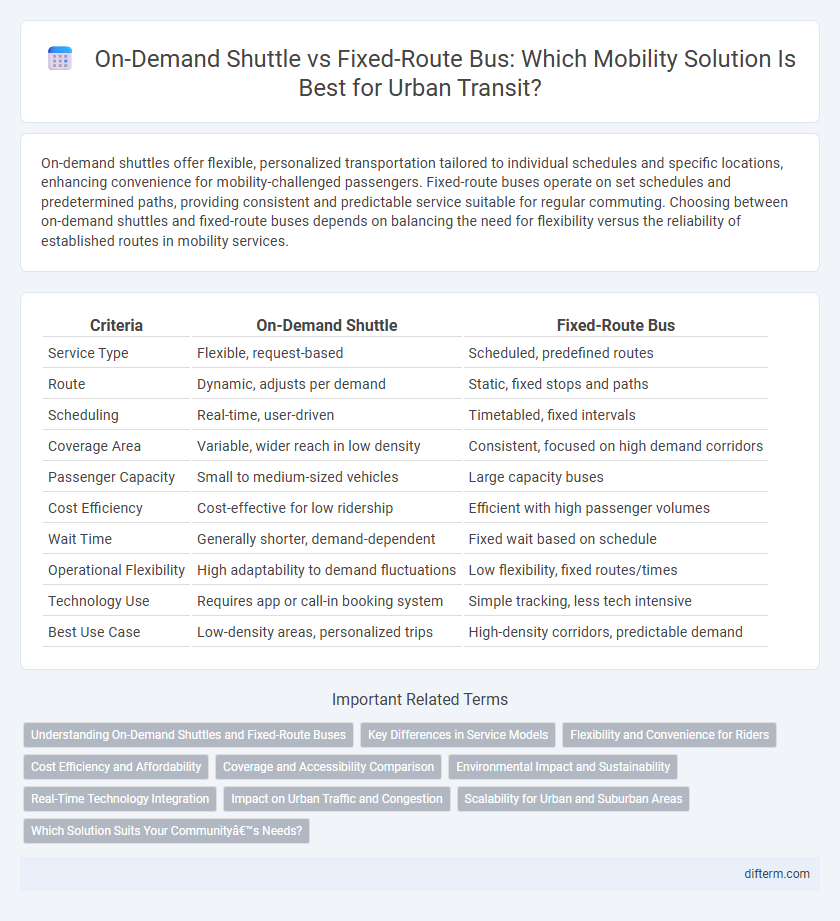On-demand shuttles offer flexible, personalized transportation tailored to individual schedules and specific locations, enhancing convenience for mobility-challenged passengers. Fixed-route buses operate on set schedules and predetermined paths, providing consistent and predictable service suitable for regular commuting. Choosing between on-demand shuttles and fixed-route buses depends on balancing the need for flexibility versus the reliability of established routes in mobility services.
Table of Comparison
| Criteria | On-Demand Shuttle | Fixed-Route Bus |
|---|---|---|
| Service Type | Flexible, request-based | Scheduled, predefined routes |
| Route | Dynamic, adjusts per demand | Static, fixed stops and paths |
| Scheduling | Real-time, user-driven | Timetabled, fixed intervals |
| Coverage Area | Variable, wider reach in low density | Consistent, focused on high demand corridors |
| Passenger Capacity | Small to medium-sized vehicles | Large capacity buses |
| Cost Efficiency | Cost-effective for low ridership | Efficient with high passenger volumes |
| Wait Time | Generally shorter, demand-dependent | Fixed wait based on schedule |
| Operational Flexibility | High adaptability to demand fluctuations | Low flexibility, fixed routes/times |
| Technology Use | Requires app or call-in booking system | Simple tracking, less tech intensive |
| Best Use Case | Low-density areas, personalized trips | High-density corridors, predictable demand |
Understanding On-Demand Shuttles and Fixed-Route Buses
On-demand shuttles provide flexible, responsive transportation by adapting routes and schedules based on real-time passenger requests, improving convenience and reducing wait times. Fixed-route buses operate on predetermined paths and timetables, offering predictable service that supports high-capacity transit and consistent coverage. Understanding these distinctions helps transit planners optimize urban mobility by balancing efficiency, accessibility, and resource allocation.
Key Differences in Service Models
On-demand shuttles operate with flexible routing based on real-time passenger requests, offering dynamic stop locations and variable schedules that adapt to rider demand. Fixed-route buses adhere to predetermined paths and timetables, providing consistent service along established corridors regardless of immediate rider volume. The service model distinction affects operational efficiency, passenger convenience, and transit network integration within urban mobility systems.
Flexibility and Convenience for Riders
On-demand shuttles offer superior flexibility compared to fixed-route buses by allowing riders to request pickups and drop-offs at specific locations and times, minimizing wait and travel times. Fixed-route buses operate on predetermined schedules and routes, which can lead to longer waits and less direct trips, reducing convenience for riders with variable schedules or destinations. This personalized service of on-demand shuttles enhances overall rider satisfaction by adapting to real-time mobility needs.
Cost Efficiency and Affordability
On-demand shuttles reduce operational costs by optimizing routes based on real-time demand, leading to lower fuel consumption and labor expenses compared to fixed-route buses with predetermined schedules. Fixed-route buses, while offering predictable service, often run underutilized during off-peak hours, increasing per-passenger costs and lowering overall affordability for transit agencies. Cost efficiency in mobility solutions favors on-demand shuttles when targeting dynamic, flexible, and scalable transportation services that align closely with passenger needs.
Coverage and Accessibility Comparison
On-demand shuttles offer flexible routes that enhance coverage by adapting to real-time passenger requests, reaching areas underserved by traditional fixed-route buses. Fixed-route buses maintain consistent schedules and stop locations, providing reliable access along predetermined corridors but often limiting reach in low-density or off-peak regions. Coverage efficiency is higher in on-demand shuttles for dispersed populations, while fixed-route buses excel in predictable, high-demand transit corridors.
Environmental Impact and Sustainability
On-demand shuttles reduce emissions by optimizing routes based on real-time demand, minimizing empty miles and lowering fuel consumption compared to fixed-route buses. Fixed-route buses, while capable of serving high volumes of passengers, often run along predetermined paths regardless of passenger load, leading to unnecessary energy use. Integrating electric or hybrid on-demand shuttles can enhance sustainability by reducing greenhouse gas emissions and promoting efficient resource utilization in urban mobility systems.
Real-Time Technology Integration
On-demand shuttles leverage real-time technology integration to dynamically adjust routes and schedules based on passenger requests, enhancing operational efficiency and user convenience. Fixed-route buses with real-time tracking offer passengers accurate arrival times and service updates but lack the flexibility of route modifications. The integration of GPS, mobile apps, and data analytics is pivotal in optimizing mobility solutions to meet diverse urban transit needs effectively.
Impact on Urban Traffic and Congestion
On-demand shuttles adapt routes based on real-time demand, reducing unnecessary miles and easing urban traffic by minimizing empty vehicle travel. Fixed-route buses follow predetermined paths regardless of rider volume, potentially contributing to congestion during off-peak hours due to less flexible operations. The dynamic routing of on-demand shuttles offers a more efficient solution for decreasing traffic density and improving flow in congested city areas.
Scalability for Urban and Suburban Areas
On-demand shuttles offer superior scalability in urban and suburban areas by dynamically adjusting routes and frequencies based on real-time demand, reducing wait times and operational costs. Fixed-route buses, while less flexible, benefit from established infrastructure and predictable schedules, which suit high-density urban corridors with consistent ridership. Combining both services can optimize coverage and efficiency, addressing diverse mobility needs across varying population densities.
Which Solution Suits Your Community’s Needs?
On-demand shuttles offer flexible routing tailored to real-time rider requests, making them ideal for communities with dispersed populations or low transit demand, ensuring efficient and convenient last-mile connectivity. Fixed-route buses serve high-density areas with established schedules and stops, providing predictable service and cost-effective capacity during peak travel times. Evaluating factors like population density, rider preferences, budget constraints, and service frequency helps determine whether on-demand or fixed-route transit best aligns with your community's mobility goals.
On-demand shuttle vs fixed-route bus Infographic

 difterm.com
difterm.com